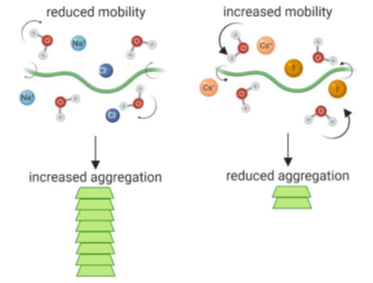The misfolding and aggregation of a specific protein, called α-synuclein (αSyn), is a distinctive feature of Parkinson's disease. A recent study used neutrons at ISIS to investigate how the presence of different salts in the water led to altering the water mobility around this protein and thereby influencing the protein mobility and its likelihood to aggregate.
For most proteins the arrangement of nearby solvent molecules, known as the solvation layer, is crucial to their function. The mobility of this solvation layer can influence the protein's interaction with other proteins and DNA, and how quickly it reacts with other molecules. It is not clear, however, how the solvation layer influences the misfolding and aggregation of proteins.
This is particularly important to understand as it is this aggregation of proteins such as αSyn that is a distinctive feature of some medical conditions, including Parkinson's disease. This study, published in Angewandte Chemie, looked in detail at how the mobility of the solvation layer influences the aggregation of αSyn proteins.
A research group, led by Professor Gabriele Kaminski Schierle from the University of Cambridge, studied the proteins in water and deuterated water-based buffers in the presence of sodium chloride (NaCl) and caesium iodide (CsI). These two salts were chosen as the ions in NaCl are small, with high charge density, whereas in CsI the ions are much larger, with lower charge density.
Using small-angle neutron scattering (SANS) on Sans2d, the researchers were able to measure the size and structure of small αSyn species formed in the different buffers early on in the aggregation pathway. They found that CsI being present decreased the rate of aggregation, whereas in both NaCl and D2O there was an increase in aggregation rate, observed by the presence of larger αSyn species. After further experiments, they found that the structure of αSyn was the same when in NaCl or CsI containing solvents, but that it was more mobile when CsI was present.
Their results show that the solvent does contribute to the aggregation of the proteins, and that the ions present can also have an influence. As the solvation layer becomes more mobile, so do the protein monomers. This means that multiple monomers are less likely to end up close enough to one another for long enough to aggregate.

“SANS enabled us to study differences in αSyn structure and size very early on in the aggregation pathway of αSyn. The structures we wanted to investigate are very small and aren't resolved with other techniques like fluorescence microscopy or quantifiable, as with electron microscopy" explains Dr Amberley Stephens from the University of Cambridge. “This work has shown that the composition of the surrounding environment, like the presence of different ions, can influence the propensity of proteins to misfold and aggregate. This poses interesting questions and areas for further research into how the cellular environment changes during aging and disease and whether this can impact protein misfolding."
